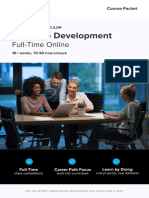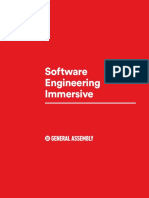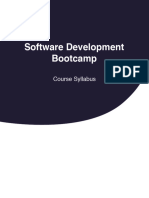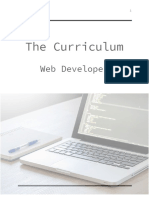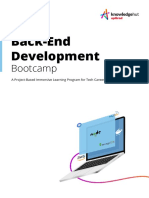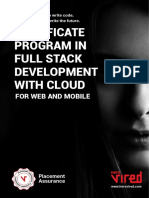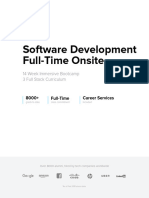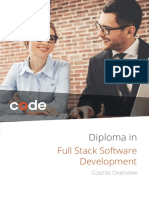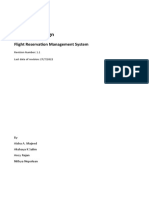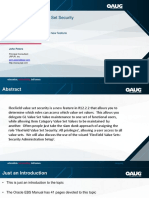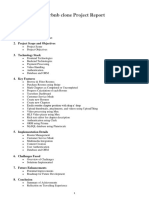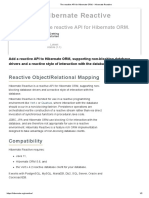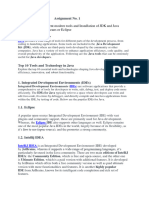MAY 2025
SOFTWARE
ENGINEERING
BOOTCAMP
Powered by Flatiron School
LEAD INSTRUCTOR
Madsen Servius
ASSISTANT INSTRUCTOR
Jean Andris Adam
�TABLE OF
CONTENTS
Course Overview 3
Software Engineering Prep 5
Curriculum 4-15
Contact Us 16
� SOFTWARE ENGINEERING BOOTCAMP SYLLABUS
COURSE
OVERVIEW
MAY 5, 2025 - OCTOBER 17, 2025
Our mission is to teach you more than simply knowing how to code. That's why our
Software Engineering Bootcamp is more extensive than the average course, covering
foundational concepts and problem-solving techniques, emerging technologies, and both
front end and back end development.
To grow as a Software Engineer, you must be agile and able to adapt, no matter the
challenge that you’re given. In our course, students will attend lectures, work through
lesson plans, and collaborate to complete group projects to gain real-world hands-on
experiences. In addition, students will hone communication skills and become part of the
tech community as they build, share and refine their GitHub portfolios.
AKADEMI | PAGE 3
� SOFTWARE ENGINEERING BOOTCAMP SYLLABUS
CURICULUM
All instruction is held within Canvas, leveraging content from our curriculum
partner, Flatiron School. The Software Engineering Bootcamp (Part-Time) is 24
weeks long and requires students to be available at minimum 20 hours per week
for the duration of the program.
Phase 1 Front End Development
Phase 2 Front End Web Applications
Phase 3 Back End Development
Phase 4 Back End Web APIs
Phase 5 Cumulative Project
AKADEMI | PAGE 4
� SOFTWARE ENGINEERING BOOTCAMP SYLLABUS
SOFTWARE
ENGINEERING PREP
All students are required to complete Software Engineering Prep one week before the start
of class, which takes 40+ hours.
Students will have a basic understanding of HTML, CSS and JavaScript by completing prep.
During prep, students will get accustomed to the Canvas leaning platform, set up their
computing environment and level set their knowledge of the basics of the programming
languages that will prepare them for day 1.
Environment Setup & The Command Line Interface
Whether students run MacOS or Windows, after acclimating to the Canvas platform, they
set up their environment in a step-by-step guide and get accustomed to the Command Line
Interface (CLI).
HTML & CSS
Students master the basic building blocks of how the web is rendered and understand the
language that makes the web beautiful. They also learn how to conceptualize and build UIs
for web apps by writing well-structured HTML and CSS to create efficient and organized
front ends.
GIT
Students begin exploring version control using git commands including forking and
branching, merging, rolling back commits, and submitting pull requests. Finally, you’ll learn
the basics of JavaScript, before diving into Phase 1.
AKADEMI | PAGE 5
� SOFTWARE ENGINEERING BOOTCAMP SYLLABUS
PHASE 1:
FRONT END
DEVELOPMENT
Functions In JavaScript
Students learn how to write functions in JavaScript, along with more advanced topics,
including arrow functions and function expressions, functions as first-class objects, and
callback functions.
Variable Scope
Students will learn about variable scope and the scope chain. This is knowledge that is
crucial to understanding how to successfully debug their code when a variable contains an
unexpected value.
Working With Data Structures In JavaScript
In this module, students learn the relationship between how to build the two most
commonly used data structures in JavaScript: Arrays and Objects. They will also learn a
variety of methods to add, remove and replace elements in Arrays and Objects.
JavaScript And The DOM
Students learn what the Document Object Model (DOM) is and how to use query methods
to select and modify DOM nodes. Students will also learn how to view their changes in the
browser, and how to use Chrome DevTools and the console to test their code.
JavaScript Events
Students learn the different types of JavaScript events while exploring how to set up event
listeners to respond to user actions such as mouse clicks, key presses, and submission of
forms. They also learn how to set up callback functions that will be executed when an event
is triggered.
AKADEMI | PAGE 6
� SOFTWARE ENGINEERING BOOTCAMP SYLLABUS
PHASE 1 (CONT):
FRONT END
DEVELOPMENT
Communicating With The Server
Students learn how the request/response cycle works, and how to send fetch requests,
handle asynchronous code execution, and fetch data from APIs.
Execution Context In Javascript
Students learn about execution context, the difference between global
and function execution contexts, and how to leverage that knowledge
to ensure their code has access to the variables and functions it needs to execute properly.
AI Assisted Debugging
Students will learn how to debug issues faster with AI models specifically trained on code
debugging, such as Phind.
Prompt Engineering
Learn to clarify misconceptions using AI chatbots. Discover examples of successful
correspondence with chatbots.
Project Assistance With AI
Students will learn how to generate project ideas or custom data for projects which may not
have publicly available APIs.
AKADEMI | PAGE 7
� SOFTWARE ENGINEERING BOOTCAMP SYLLABUS
PHASE 2:
FRONT END WEB
APPLICATIONS
Introduction To React
In this module, students learn the benefits of leveraging the ReactJS framework to build
applications. They will also learn how to set up and use Node Package Manager to add
functionality to a JavaScript project, and continue to develop their skills in running tests
and interpreting test output.
Components And Props
Students learn how to quickly and easily create React applications using React components.
They will learn how to write the JSX used to build the HTML on the page, and how to pass
information between components using props.
State And Events
In this module, students dive deeper into React and the event system. They learn how to
attach event listeners to JSX elements and pass a callback function to handle the event. In
addition, students learn more about the React state system and how to differentiate
situations where they would use state vs. props within a component.
Side Effects And Data Fetching
Students learn about side effects in React, and how to use the useEffect hook to make
network requests and get data. Students will understand use cases for fetch requests
prompted by user actions vs. automatically fetching data using the useEffect hook.
AKADEMI | PAGE 8
� SOFTWARE ENGINEERING BOOTCAMP SYLLABUS
PHASE 2 (CONT):
FRONT END WEB
APPLICATIONS
Client-Side Routing
Students learn how client-side routing works within React and how to use it to mimic the
navigation behavior of multi-page applications without sacrificing speed.
AI Assisted Auto Completion & Automated Testing
Learn how to leverage AI tools to enable code completion. Students will also learn how AI
tools can generate unit tests for components, which ultimately will give them an edge in a
job search.
AKADEMI | PAGE 9
� SOFTWARE ENGINEERING BOOTCAMP SYLLABUS
PHASE 3:
BACK END
DEVELOPMENT
Python Fundamentals
Students begin learning the back end programming language, Python, building on the
programming concepts they learned from JavaScript. Students will learn how Python syntax
differs from JavaScript and how to construct conditional statements and loops in Python.
Python Fundamentals: Data Structures
Students build on their knowledge of Arrays and Objects in JavaScript to learn how to work
with the corresponding data structures in Python: lists and dictionaries. They will be able to
leverage their familiarity with the JavaScript methods used to create and modify Arrays and
Objects in building the same skills using Python.
Introduction To Object-Orientation In Python
Students learn the basics of Object-Oriented Python, including classes and instances, local
variables and instance variables, and assigning attributes and properties to objects through
use of the “self” keyword. Students will also learn setter and getter methods to assign
properties and retrieve their values.
Topics In Object-Orientation - Class Variables And Methods
In this module, students learn to use class methods, class variables, and class constants to
expand on the class’s functionality. They will learn best practices for building classes that
use class variables to keep track of data, and class methods to show the data pertaining to
the class.
AKADEMI | PAGE 10
� SOFTWARE ENGINEERING BOOTCAMP SYLLABUS
PHASE 3 (CONT):
BACK END
DEVELOPMENT
Topics In Object-Orientation - Object Inheritance
In this module, students learn how to use inheritance and modules to refactor out
redundancies and write more efficient code. They will learn how to use inheritance to write
families of classes that have both shared and unique attributes and behaviors. They will also
learn how to use modules to bundle methods that can then be used by any number of
classes. Students will learn how they can use these techniques to write code that is DRYer
(Don’t Repeat Yourself), lighter, more intuitive, and scalable.
Getting Started With SQL
During this module, students set up a SQLite database, create, update and delete data from
database tables and create advanced queries. They will learn how to create tables that
include various data types, use the SQL insert, delete and update commands to modify
tables, and use the select command along with SQL modifiers and aggregate functions to
construct sophisticated queries of the database.
Table Relations In SQL
Students learn how to construct a relational database using primary and foreign keys.
Students practice associating two tables together using a foreign key column, retrieving
specific sets of data from associated tables using join statements, and creating one-to-many
and many-to-many relationships.
Object Relational Mapping
Students learn about Object Relational Mapping which allows the use of an object-oriented
programming language such as Python to manage database data and avoids the need to
write SQL directly. This results in less repetitive, more intuitive code.
AKADEMI | PAGE 11
� SOFTWARE ENGINEERING BOOTCAMP SYLLABUS
PHASE 3 (CONT):
BACK END
DEVELOPMENT
AI Model Integration
Once students understand Python basics, they will learn to integrate AI features into their
apps. They will learn to summarize content, make inferences based on user-provided
content, or generate new content based on analysis.
Using SQLAlchemy
Students learn everything they need to know to use one of the most popular object-
relational mappers: SQLAlchemy. Students understand how they can use SQLAlchemy to
create clean, efficient code that is easier to read, write, and maintain, with queries that are
more intuitive and efficient. Additionally, students are introduced to Alembic, a migrations
manager that allows them to automate database editing tasks from the terminal.
SQLAlchemy Relationships
In the final module of Phase 3, students learn how they can use SQLAlchemy methods to
create relationships between the models in their application, as well as how those
relationships can help them create more sophisticated queries with simple, clean code.
Using SQLAlchemy
Students learn everything they need to know to use one of the most popular object-
relational mappers: SQLAlchemy. Students understand how they can use SQLAlchemy to
create clean, efficient code that is easier to read, write, and maintain, with queries that are
more intuitive and efficient. Additionally, students are introduced to Alembic, a migrations
manager that allows them to automate database editing tasks from the terminal. In the final
module of Phase 3, students learn how they can use SQLAlchemy methods to create
relationships between the models in their application.
AKADEMI | PAGE 12
� SOFTWARE ENGINEERING BOOTCAMP SYLLABUS
PHASE 4:
Back End Web APIs
Python Flask Fundamentals
Students learn the fundamentals of Flask from building single-file applications to
understanding the flow of data. Additionally, they begin to implement data processing into
their Flask applications with Flask-SQLAlchemy and Flask-Migrate.
CRUD with Flask
In the CRUD with Flask module, students learn to build out CRUD actions (Create, Read,
Update, Delete) in the back end using the 5 common RESTful routes and their
corresponding actions in Flask. They also learn how to properly format a response with a
JSON body and HTTP status codes.
Validations
Students learn the common methods for implementing validations on models using
SQLAlchemy to ensure that no bad data ends up in the database. During this module,
students write both basic validations using SQLAlchemy constraints as well as custom
validations. They also implement error handling by writing code to send error messages in
response to HTTP errors, pinpointing how to fix the request.
Full Stack Development
Students build new Flask API backends for their first full stack applications. Students get
hands-on experience adding a React front end to their Flask API and setting it up to make
fetch requests to the Flask server in response to user actions. Students will also learn about
WebSocket, a protocol for maintaining constant connection between a client and server.
AKADEMI | PAGE 13
� SOFTWARE ENGINEERING BOOTCAMP SYLLABUS
PHASE 4 (CONT):
Back End Web APIs
Serialization
In the Serialization module, students learn how to use Active Model
Serializer to customize the JSON that is returned from the back end. By using SQLAlchemy
Association macros in combination with Serializer, students are able to maintain very fine
control over the JSON their application returns with a minimum of code.
Authentication
Students learn the fundamentals of cookies, how to configure it for Flask in API mode, and
how to leverage cookies and sessions to log users into an application. In addition, students
build out a full authentication and authorization flow using sessions and cookies in Flask,
including login, keeping users logged in, logout, and restricting access to secure
information. Students will also learn how to use external resources to handle user
passwords safely and securely.
Deploying
In this module, students learn the fundamentals of packaging and deploying applications
using WSGIs and online deployment platforms to deploy a full stack Flask-React
application.
AKADEMI | PAGE 14
� SOFTWARE ENGINEERING BOOTCAMP SYLLABUS
PHASE 5:
CUMULATIVE PROJECT
In Phase 5, the final phase of the course, students begin working on their capstone project.
The capstone is a solo-project that allows students to create an application of their choice
leveraging the technologies that they have learned throughout the course. Students work
with instructors to come up with project concepts and spend dedicated time to build truly
sophisticated applications on their own.
While building out the application, students will receive plenty of instructor feedback and
dive deeper into various advanced technologies to bring the concept to life.
During Phase 5, students have access to bonus materials and are encouraged to work on
the provided algorithm practice challenges to prepare for live coding assessments that are
often part of technical interviews.
AKADEMI | PAGE 15
�QUESTIONS?
CONTACT US.
At Akademi, we’re committed to helping you
learn the skills to start or elevate your career.
Contact us for any additional information about
the Software Engineering Bootcamp.
www.myakademi.co
info@myakademi.co




